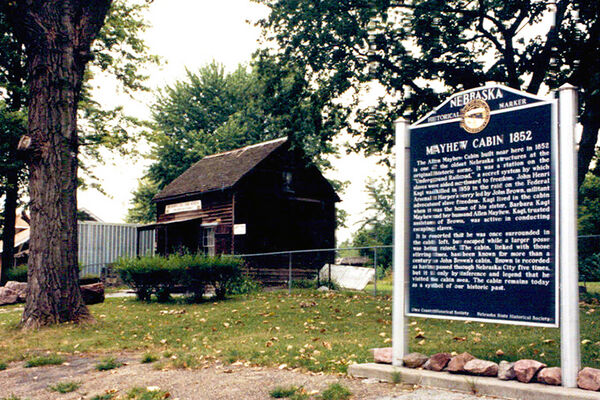Nebraska Historical Marker: Mayhew Cabin, 1855
Location
2012 4th Corso, Nebraska City, Otoe County, Nebraska
View this marker's location 40.673348, -95.87018
View a map of all Nebraska historical markers, Browse Historical Marker Map
Marker Text
This cabin, one of Nebraska's oldest structures, was built in the summer of 1855 as the home of Allen B. Mayhew, his wife, Barbara Ann (Kagy) Mayhew, and their sons, Edward and Henry. John Henry Kagi, Barbara Mayhew's brother, lived briefly with the Mayhews before joining abolitionist John Brown in Kansas. In February 1859 Kagi helped Brown lead eleven Missouri slaves to freedom in Iowa via Nebraska City. During the trek Kagi narrowly avoided arrest while at the cabin. He was killed in October 1859 during Brown's raid on the Harpers Ferry, Virginia, arsenal to seize weapons for a slave uprising. Beginning in the 1870s, stories and recollections about this turbulent era credited the cabin as an Underground Railroad station. Edward Mayhew recalled Kagi once bringing fourteen black persons (possibly escaping slaves) to the cabin for breakfast. When the cabin was moved several feet in the 1930s due to highway construction, a "cave," allegedly used to hide freedom-seeking slaves, was recreated nearby. Legends connecting John Brown to the Mayhew cabin made it a popular tourist attraction devoted to the antislavery cause.
Further Information
Nebraska State Historical Society historian, James E. Potter, investigates the connection of John Brown to the Mayhew cabin in an article published in Nebraska History. The article examines available evidence in order to determine the extent to which John Brown’s Cave and the adjacent Mayhew log cabin in Nebraska City may or may not have contributed to the escape of fugitive slaves. It has been alleged that through Brown’s direct involvement, the “cave” was an important Underground Railroad station, sheltering scores if not hundreds of black fugitives who were making their way out of bondage. The article debunks the story of the cave, concluding that it is an example of folklore that demonstrates how generations of Nebraskans have come to regard the crusade against slavery as a meaningful part of their past. See "Fact and Folklore in the Story of ‘John Brown’s Cave’ and the Underground Railroad in Nebraska," Nebraska History 83 (2002): 73-88. [DM]
Bibliography
James E. Potter, "Fact and Folklore in the Story of ‘John Brown’s Cave’ and the Underground Railroad in Nebraska," Nebraska History 83 (2002): 73-88
Marker program
See Nebraska Historical Marker Program for more information.
